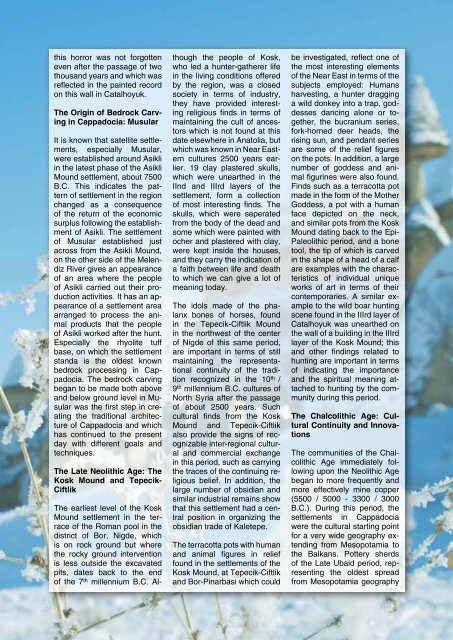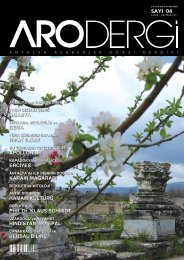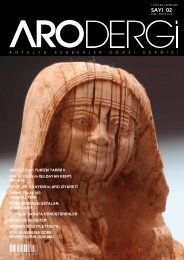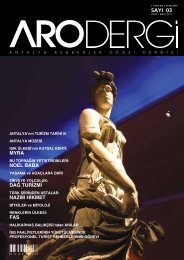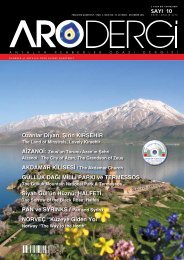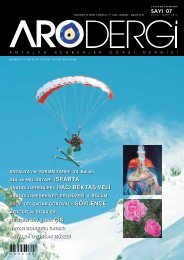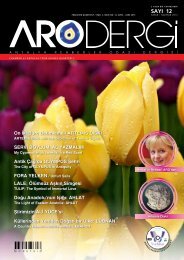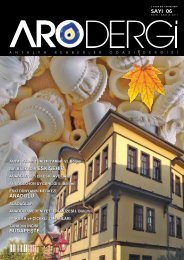Sayı 11- Ocak/Mart 2013 - Antalya Rehberler Odası
Sayı 11- Ocak/Mart 2013 - Antalya Rehberler Odası
Sayı 11- Ocak/Mart 2013 - Antalya Rehberler Odası
- No tags were found...
Create successful ePaper yourself
Turn your PDF publications into a flip-book with our unique Google optimized e-Paper software.
this horror was not forgotteneven after the passage of twothousand years and which wasreflected in the painted recordon this wall in Catalhoyuk.The Origin of Bedrock Carvingin Cappadocia: MusularIt is known that satellite settlements,especially Musular,were established around Asikliin the latest phase of the AsikliMound settlement, about 7500B.C. This indicates the patternof settlement in the regionchanged as a consequenceof the return of the economicsurplus following the establishmentof Asikli. The settlementof Musular established justacross from the Asikli Mound,on the other side of the MelendizRiver gives an appearanceof an area where the peopleof Asikli carried out their productionactivities. It has an appearanceof a settlement areaarranged to process the animalproducts that the peopleof Asikli worked after the hunt.Especially the rhyolite tuffbase, on which the settlementstanda is the oldest knownbedrock processing in Cappadocia.The bedrock carvingbegan to be made both aboveand below ground level in Musularwas the first step in creatingthe traditional architectureof Cappadocia and whichhas continued to the presentday with different goals andtechniques.The Late Neolithic Age: TheKosk Mound and Tepecik-CiftlikThe earliest level of the KoskMound settlement in the terraceof the Roman pool in thedistrict of Bor, Nigde, whichis on rock ground but wherethe rocky ground interventionis less outside the excavatedpits, dates back to the endof the 7 th millennium B.C. Althoughthe people of Kosk,who led a hunter-gatherer lifein the living conditions offeredby the region, was a closedsociety in terms of industry,they have provided interestingreligious finds in terms ofmaintaining the cult of ancestorswhich is not found at thisdate elsewhere in Anatolia, butwhich was known in Near Easterncultures 2500 years earlier.19 clay plastered skulls,which were unearthed in theIInd and IIIrd layers of thesettlement, form a collectionof most interesting finds. Theskulls, which were seperatedfrom the body of the dead andsome which were painted withocher and plastered with clay,were kept inside the houses,and they carry the indication ofa faith between life and deathto which we can give a lot ofmeaning today.The idols made of the phalanxbones of horses, foundin the Tepecik-Ciftlik Moundin the northwest of the centerof Nigde of this same period,are important in terms of stillmaintaining the representationalcontinuity of the traditionrecognized in the 10 th /9 th millennium B.C. cultures ofNorth Syria after the passageof about 2500 years. Suchcultural finds from the KoskMound and Tepecik-Ciftlikalso provide the signs of recognizableinter-regional culturaland commercial exchangein this period, such as carryingthe traces of the continuing religiousbelief. In addition, thelarge number of obsidian andsimilar industrial remains showthat this settlement had a centralposition in organizing theobsidian trade of Kaletepe.The terracotta pots with humanand animal figures in relieffound in the settlements of theKosk Mound, at Tepecik-Ciftlikand Bor-Pinarbasi which couldbe investigated, reflect one ofthe most interesting elementsof the Near East in terms of thesubjects employed: Humansharvesting, a hunter dragginga wild donkey into a trap, goddessesdancing alone or together,the bucranium series,fork-horned deer heads, therising sun, and pendant seriesare some of the relief figureson the pots. In addition, a largenumber of goddess and animalfigurines were also found.Finds such as a terracotta potmade in the form of the MotherGoddess, a pot with a humanface depicted on the neck,and similar pots from the KoskMound dating back to the Epi-Paleolithic period, and a bonetool, the tip of which is carvedin the shape of a head of a calfare examples with the characteristicsof individual uniqueworks of art in terms of theircontemporaries. A similar exampleto the wild boar huntingscene found in the IIIrd layer ofCatalhoyuk was unearthed onthe wall of a building in the IIIrdlayer of the Kosk Mound; thisand other findings related tohunting are important in termsof indicating the importanceand the spiritual meaning attachedto hunting by the communityduring this period.The Chalcolithic Age: CulturalContinuity and InnovationsThe communities of the ChalcolithicAge immediately followingupon the Neolithic Agebegan to more frequently andmore effectively mine copper(5500 / 5000 - 3300 / 3000B.C.). During this period, thesettlements in Cappadociawere the cultural starting pointfor a very wide geography extendingfrom Mesopotamia tothe Balkans. Pottery sherdsof the Late Ubaid period, representingthe oldest spreadfrom Mesopotamia geography


